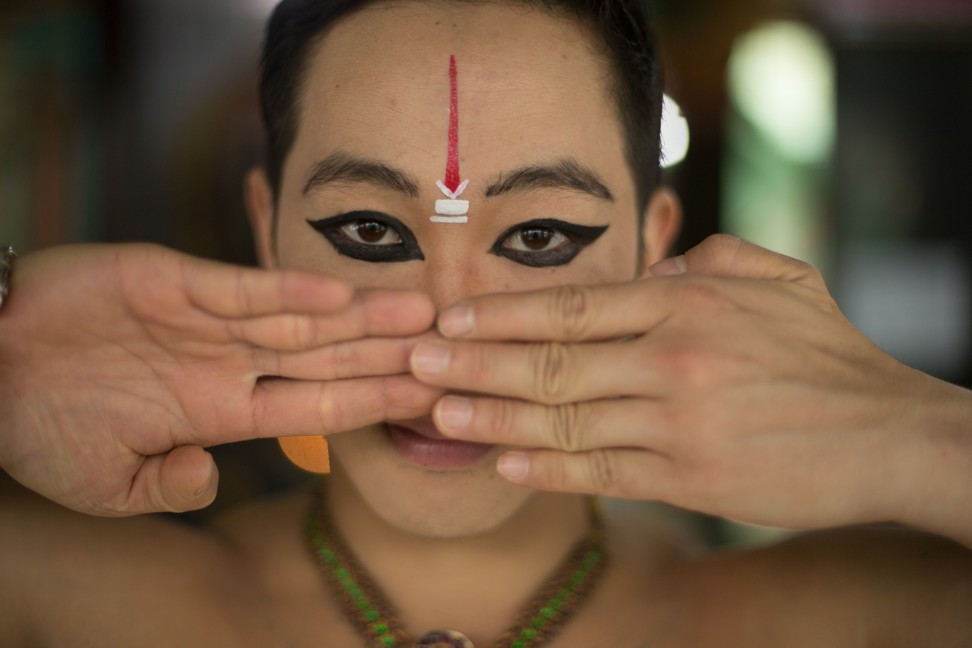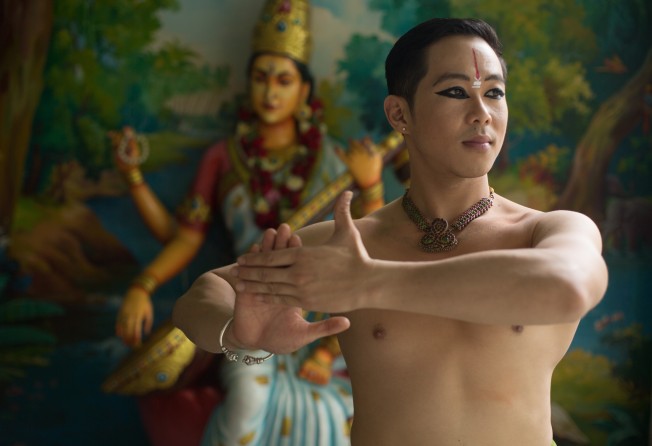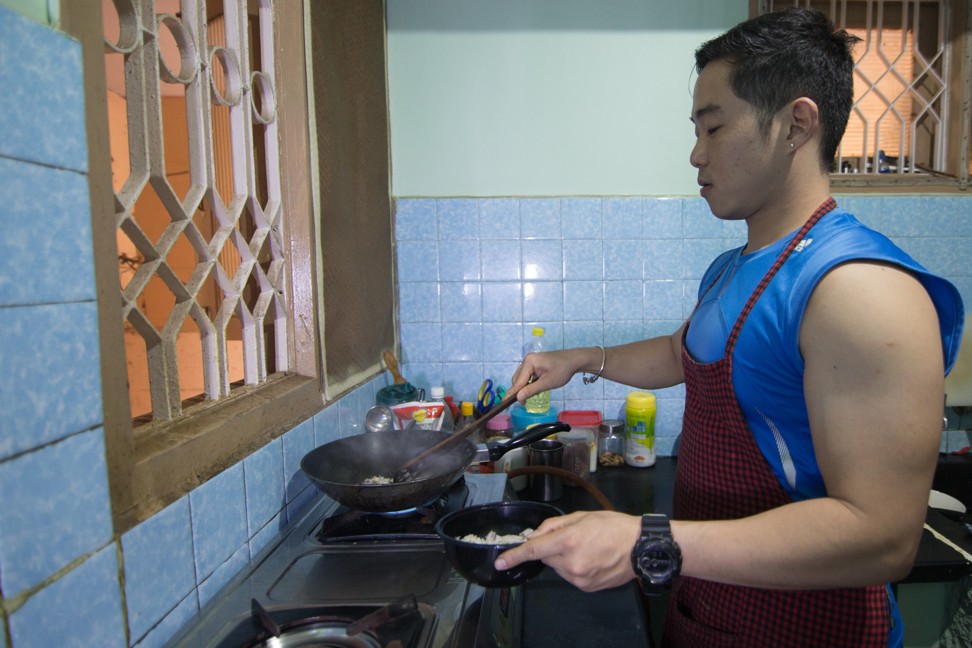
The dancer breaking racial and gender stereotypes in India: a mixed-race man in an Indian woman’s world
- He may look more Chinese, but Charles Ma doesn’t let tradition stop him from dancing Bharatanatyam, which is usually performed by Indian women
- When he started he was told his eyes were too small, and later a teacher asked him to wear pink lipstick and earrings for a performance

Chinki is an ethnic slur used in India, mostly to refer to people of Chinese origin. For those who use it, the Chinese are chinkis, but so are the Nepalis, and even the people of northeastern Indian states.
Dance teacher and performer Charles Ma ignores such racial insults. “If someone called me ‘chinki’ when I was growing up, I would say ‘abbey ja na’ [‘go take a hike’],” he says. “I couldn’t care less.”
Neither did he let it put him off learning Bharatanatyam, a form of Indian classical dance traditionally featuring Indian women with big painted eyes.
“You have such small chinki eyes,” Ma says someone told him 15 years ago when he was learning the dance form. “Bharatanatyam dancers have big eyes. Why not learn something else?”

In Bharatanatyam, the nayika (heroine) uses her highly expressive eyes and hand gestures to convey a range of emotions – the exultation of meeting a lover, for instance, or the pain of being separated.
Most people would imagine it performed by an Indian woman with eyes painted with kohl – an ancient eye cosmetic – and long dark hair, wearing a rich silk sari and ornate gold jewellery. So when a young man with an apparently Chinese face went knocking on the doors of Bharatanatyam teachers, quite a few pointed out he was not the right fit.
“One of them told me that I danced very well for a foreigner,” says Ma, who has trained under many teachers in the past 20 years. “Finding a guru was hard. I was a troublesome teenager and demanded them to be on the same page as me.”
He was working as a contemporary dance choreographer when he made his debut Bharatanatyam performance in 2008. Four years after that, he started teaching the dance to children.
Ma says his grandfather migrated to India from China after Mao Zedong’s Communist Party claimed victory in the civil war, a stowaway in a charcoal ship. In India, he fell in love with a Nepali woman and married her. Ma’s father was half-Chinese and half-Nepali, while his mother grew up in India’s eastern state of West Bengal.

His mother’s parents died when she was young and she does not know her family background, having been raised by her siblings.
“When you are raised by your siblings, it becomes a matter of survival,” Ma says. “More than ‘who we are and where we came from’, what bothers you is ‘what are we going to eat tomorrow’. But I believe she is from northeast India and she grew up in West Bengal. In fact, for a long time, I didn’t realise that I had so many Bengali words in my vocabulary. Growing up, when I wanted to say that the food was very spicy, I would say ‘it’s so jhaal’ [spicy], leaving my friends perplexed.”
Ma grew up in the southern Indian city of Bangalore about 350 kilometres (220 miles) west of Chennai, where his mother works as a beautician and his father as a chef.
“These were the typical vocations Chinese immigrants took up at that time in South India,” Ma says. “They were beauticians, dentists or involved in leather works. But we lived like a typical South Indian middle-class family. My house would have the aroma of south Indian food. My food habits are purely South Indian; I am a rice person. My tongue rolls a certain way and I have a thick South Indian accent. Even my genes are getting altered, I feel, and I am losing my roots.”

Recalling his childhood, Ma says Bangalore was not like the tech hub it is now.
“It was truly India’s garden city. We had a lot of wildlife around. My neighbours used to have goats and hens. Langurs [monkeys] would come to our house. Rare birds would fall and we would rehabilitate them. We would see owls,” he says.
“I remember I once spotted a peacock in the heart of the city. It was so beautiful. The place looked so alive. All this had a very strong impact on my personality as a dancer and my abhinaya [expressions and gestures].”
The 35-year-old now teaches Bharatanatyam to a range of students, from children as young as five to adults his age. He complains that children these days can’t connect with nature or Indian mythology, the two essential themes of Bharatanatyam.
“In my school, we used to have a football ground so huge that you could not run across it. At home, we would watch the Ramayana [an ancient Indian epic adapted as a television series] as kids. But today, these spaces have been taken over by phones and video games,” he says.
“Kids are very intelligent these days, but they lack this cultural visual memory. They can’t relate, for instance, when we are enacting a scene of a goddess killing a demon. How do you teach them to express that fury when they are not familiar with the legend? So we need to constantly evolve and update our pedagogy skills.”

It is believed Bharatanatyam was originally performed by devadasis, the girls and women who were given to the service of a deity in south Indian temples in ancient times.
When India became a British colony, the new rulers banned the dance, citing its strong references to sexuality, and slavery to idols. It was later revived, but over time Bharatanatyam lost the elements of eroticism it had earlier featured and came to be strongly associated with religious themes. For some time, it was only performed by upper caste Brahmin women of south India.
“Colonialism brought a puritanical approach to the dance,” Ma says. “In ancient India, sex was celebrated. There were art forms around polygamy and sex, and there were such strong sensual elements associated with the dance. I remember a song where the protagonist is telling her friend about the beautiful sex she had. But all this is gone now.”
Why do I need to look like a woman to dance? When I learned dancing, Bharatanatyam was reserved for women. The few boys who did it were made fun of and were called effeminate or gay … But I knew that if I danced, I would dance like a man
About seven years ago, Ma was interviewed by a senior Bharatanatyam dancer and writer, Tulsi Badrinath, and his controversial opinions infuriated the small Bharatanatyam community in Bangalore.
In Badrinath’s book, titled Master of Arts: A Life in Dance, she quotes Ma as saying: “In Bangalore, there are no good gurus. Everything is in bits and pieces.” This, along with his comments on some teachers, triggered an outpouring of criticism. Veterans denounced him for his “insensitivity” and demanded an apology. Senior art critic Usha RK called him “totally reckless, presumptuous, brash and impudent” in her blog.
Ma says he was naive and misquoted, but adds that a lot of incapable people are making a lot of money teaching Bharatanatyam in southern India.

Once Ma’s teacher asked him to wear pink lipstick and her daughter’s earrings for a dance performance. He refused and quit the classes. After a long period of searching for a guru, he returned on the condition that his teacher wouldn’t interfere with his make-up.
“Why do I need to look like a woman to dance?” he says. “When I learned dancing, Bharatanatyam was reserved for women. The few boys who did it were made fun of and were called effeminate or gay. In my case, it was especially difficult as I was an outsider – a fair and frail boy who looked girlish with kohl make-up around his eyes.
“But I knew that if I danced, I would dance like a man. Male Bharatanatyam dancing has its own beauty. It’s strong and geometric.”
Ma’s favourite theme as a Bharatanatyam dancer is love.
“I think love is a very beautiful thing,” he says. “And Bharatanatyam explores it endlessly. There are pieces where a nayika is describing eight moods of love. There are pieces about a woman who is married and loyal to one man, and then there are pieces about a woman who is married to a man but in love with another. So it’s very beautiful, and yet painful to act some of them.”
He feels that the gestures are the most important part of the dance.
“I think it comes from a place deep within,” he says. “And culture has a very significant role to play. I see many foreigners coming to India and they perform classical dances. They are able to learn the techniques, but their abhinaya is very different. In my case, I grew up in south India and have a very strong understanding of the culture and local languages. So I get it well.”
Asked if people still call him “chinki”, he laughs.
“Well, now they call me ‘Chinese teacher’. You see, I may look like an outsider, but in my head, I am a hard-core south Indian man. It’s just the facade.”